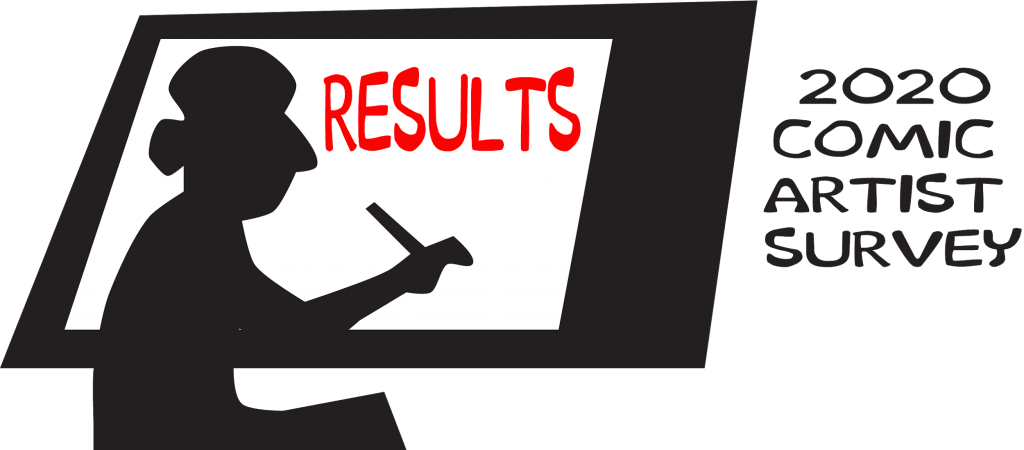
Introduction to Part Two of the 2020 Comics Arts Stakeholder Survey
The second part of the 2020 Comic Artist Survey is focused on the role of Nonprofit Organizations (NPOs) in the comic arts community. Generally speaking, NPOs exist to address issues of market failure, government failure, or a failure of the civic sector in recognizing, perpetuating, and evolving a public good that is not a marketable commodity or governable right. In the specific instance of this survey, that public good would be the value of the comic arts to society as a whole. To address those issues, NPOs (as well as less formal groups with ties to social movements such as activists and advocates) use a model for attempting social change that involves three distinct steps: Problem Framing, Problem Solving, and Solution Implementation. The questions in this part of the survey are reflective of NPOs needing stakeholder input on all three steps to successfully create that social change.
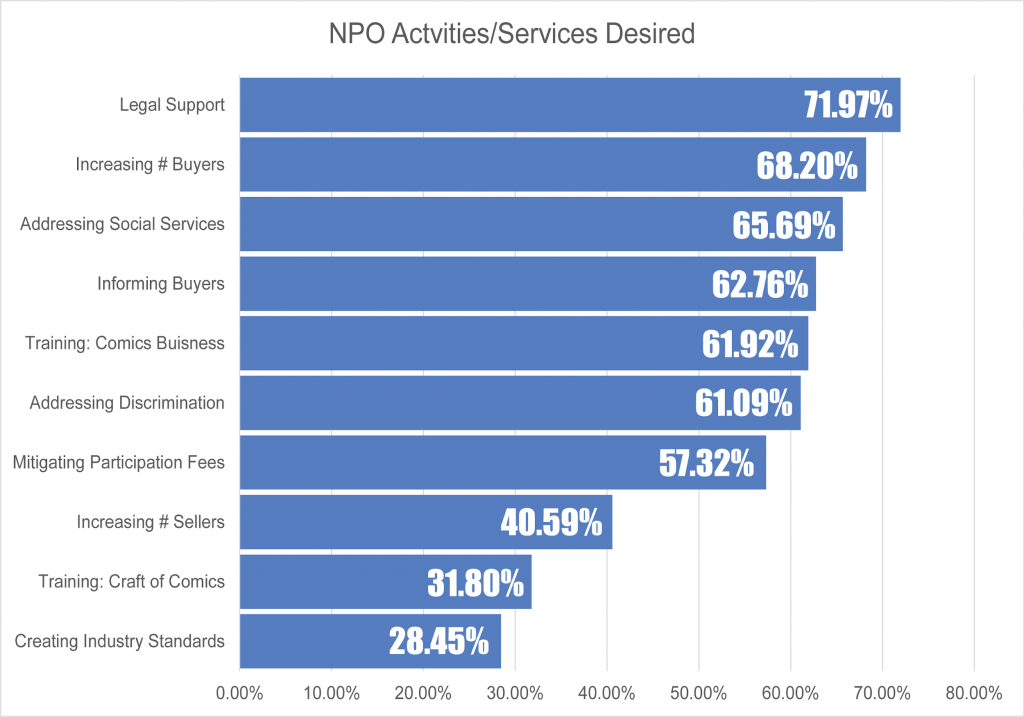
Activities desired from NPOs
The goal of this question was to use a set of proposed problem solutions to back into problem framing. Respondents were presented with five solutions to market failure (Increasing the number of Buyers, Increasing the number of Sellers, Mitigating Participation fees, Informing Buyers about artist work, and Creating Standard Formats and pricing) and five solutions to problems that are external to the market and more of a matter of community (Addressing discrimination, Addressing social service gaps, Training in the craft of making comics, Training in the business of making comics, and Legal support in matters of censorship and copyright).
7 of the 10 proposed NPO activities presented were desired by the majority of the overall respondents and all subcategories (see Part One), showing that there are a significant number of perceived market, government, and cultural facets perceived as issues by the responding comic artists.
Legal Support: The need for Legal Support with issues of copyright and censorship reflects issues with the structure of the marketplace as opposed to actual actions within the marketplace. It also involves a group of stakeholders not specifically addressed in this study: The Stakeholders who create, enforce, and interpret laws and regulations in some ways define the shape of the comic artist identity and stakeholders who exploit the resources of Comic Artists. These other stakeholders, often with a higher degree of power and a lower degree of interest than either the artists or NPOs, make the issue of providing legal support particularly tricky.
Legal support is the number one most desired activity for overall respondents and in the Enfranchised, Clear Path, Insider, Outsider, Professional, and Hobbyist subcategories. It is the second most requested service by the Disenfranchised and Unclear Path subcategories. The rate at which respondents state that they desire Legal support is consistent for all groups except for Professionals, who request the services at a higher rate (76.74%).
38% of Second Party Stakeholders correctly estimated the percent of respondents who would be interested in Legal support with a tendency to overestimate when incorrect.
Given the involvement of other powerful stakeholders, it makes sense for NPOs to engage in legal support activities as advocates, using what resources and skills they have to amplify the voice of Comic Artists. In the specific case of copyright issues, there is potential for overlap between this activity and that of Training in the Business of Making Comics, which would empower Comic Artists with the necessary skills to file and enforce their own copyrights to the extent possible before actual litigation occurs.
Increasing Buyers: In terms of market failure, increasing the number of buyers in the market place is perhaps the most “No Duh” response. More buyers equal more money in the marketplace and a bigger pie to slice up between stakeholders.
Overall Respondents as well as stakeholder identities Comics Insiders, Comics Outsiders, Clear Path, Unclear Path, and Professional all desire NPO activities aimed at increasing the number of buyers at a consistent rate.
Notably, a high number of Enfranchised respondents (75%) would like to see an increased number of buyers, but Disenfranchised and Hobbyist stakeholders are less likely (at 59.22% and 55.77% respectively).
In the case of Hobbyists, this is likely owing to their general disassociation from the market place. Hobbyists don’t rely on comics for income, so they have less stake in increasing the size of the market. A portion of the Disenfranchised stakeholders likely sees reducing barriers to participating in the market palace as more beneficial than merely increasing the size of a market that they already have limited access to. The existing system works for the Enfranchised stakeholders, so seeing it grow is seen as most beneficial.
The issue of increasing the number of buyers faces a problem of stakeholder recruitment, though. Where do you find these new buyers? How do you persuade them to go from being a non-fan to a fan? An excessive emphasis on increasing the number of buyers may have the effect of alienating a portion of the Disenfranchised stakeholder population who sees the same barriers to participation barring their access to the new buyers as well. The high degree of respondents who would like to see Value Guardian type NPOs (see the NPO functions question, below) correlates strongly with the desire to see increased buyers.
Addressing Social Service Gaps: As with any group that subsists largely on contract and gig work, comic artist stakeholders who rely on freelance work are often plagued by issues such as lack of medical coverage, housing, food, and education.
The desire to see NPO activities addressing social service gaps has a high degree of variability from Comic Artist Identity stakeholder subcategories. Comics Insiders and Professionals are consistent with the overall results.
Enfranchised (58.09%), Comics Outsider (59.09%), and Hobbyist (52.24%) stakeholders see less need, likely tied to their increased rate of full-time employment. Clear Path stakeholders also see less need for social services (59.66%), despite less full-time employment.
Disenfranchised (74.76%), and Unclear Path (71.07%) respondents express a higher than overall rate of wanting social services from NPOs. For Disenfranchised stakeholders, this is likely of being at an intersection point where the barriers in place because of their cultural identity are exacerbated by the barriers present in their comic artist identity. The higher rate for Unclear Path respondents is harder to pin down in terms of cause, especially given that, as a group, they have a greater degree of full-time employment. It is possible that the Unclear Path respondents tend towards full-time jobs of the sort with no or subpar benefits. It is also possible that these respondents see the lack of social services experienced by comic artists as a barrier to quitting their day job and going full- time. Whatever the reason, it is an area for potential deeper study.
Second Party stakeholders only correctly estimated the number of respondents who wanted social service help 25% of the time. The Second Parties show a bias towards overestimating (40%)
NPOs that are service providers and advocates are well suited to dealing with social service gaps. Service Providers are generally better suited to dealing with urgent and dire issues. Advocates are suited for attempting policy changes for the community. There is some room for Service Innovators to attempt both solutions to immediate and long term changes, but they face a moral issue due to the experimental issue of being an innovator. Is it fair to ask Comic Artists in need of basic human necessities to take part in programs with a higher degree of risk?
Informing Buyers: Activities that Inform buyers about Comic Artists are a service that directly addresses one of the more obvious causes of market failure: Information disparities.
All Comic Artist Stakeholder Identity subgroups see this at a similar rate.
At 68.64%, Comics Insider stakeholders are the only group that sees a significantly greater need than the others. This is perhaps an insight gained from observations made while working within the comic arts community in a capacity other than as an artist.
A good number (42%) of Second Party Stakeholders recognize the need for these services, with a slight bias towards estimating high.
Like increasing the number of buyers, this activity is tailor-made for Value Guardian type NPOs, who deal in growing the general knowledge about the Comic Arts community as a whole, but there is also room for Service Providers and Service Innovators. All NPOs attempting to inform buyers face a dilemma in that their resources are limited but they face a stakeholder population that has a strong desire for inclusivity and equitability. How does an NPO decide which artists they inform buyers about in a fair manner?
Training in Making Comics – Business: The goal of training Comic Artists in the business of making comics isn’t to alter the market factors directly, but instead to change the relationship of artists to those factors through education. Comic artists who are better prepared to navigate the marketplace will make better decisions and have more success.
The desire for training in the business of making comics is consistent in the overall responses among the Professional, Hobbyist, Enfranchised, Disenfranchised, Clear Path, Unclear Path, and Comics Outsiders stakeholder groups. It is notably more important to Comic Insider respondents at 66.94%. This is an interesting result in that expectations might reasonably be that Comics Insiders already have a greater knowledge of how the comics industry works. The Comic Insiders higher rates of part-time and freelance work may be indicative of barriers that they have run into in the business and would like to learn to surmount.
Many Second Party respondents correctly estimate the number of artists who desire business training (48%).
“Training” inherently implies that the Service Providers are the best NPOs to tackle these needs in the comic artist community. Taken from the perspective that the Comic Arts business isn’t necessarily all that different from other businesses, there may be an innovative solution as well wherein general business training, such as reading contracts, business writing, software proficiency, and other administrative skills, is made available to comic artists.
Addressing Discrimination: The majority of comic artists recognize that discrimination is and has been an issue in the community. This is evident in part by a higher rate of Disenfranchised respondents beginning about 18 years ago according to responses to the career length question. The community has also begun to acknowledge the value and strengths brought by diversity.
Still, there is a lot of variation between stakeholder subcategories and the overall response. It is consistent with the overall response among Enfranchised, Clear Path, and Unclear Path respondents. Addressing discrimination is notably less important to Comics Outsiders (53.64%) and Hobbyists (51.92%) and, notably, more important to the Disenfranchised (66.99%), Comics Insiders (66.10%), and Professionals (72.09%). The reason for this increase on the part of Disenfranchised stakeholders seems fairly obvious. Comics Insiders and Professionals are likely have greater insight into the workings of the comics industry, so it is noteworthy that those stakeholder subcategories perceive a greater than the overall average desire to see NPOs address Bias. Both Comics Insiders and Professionals show a greater desire for Advocates and the value of Transformation, supporting this.
A Majority (65%) of Second Party Stakeholders correctly estimate the percent of overall respondents who desire these activities with a slight tendency to overestimate.
While advocacy centered NPOs are best suited to deal with reported instances of discrimination, it is necessary for all NPOs to wrestle with both the immediate problems and the history of bias in the Comic Arts community. This is evident in that there is a perceived need by both the Artist Stakeholders who are intimate with the industry and the second party outside point of view seeing a need for these services.
Mitigating Participation Fees: It is not necessarily free to enter the comic arts market. The easiest and most obvious example of this comes in the form of table fees at fairs and conventions, but there are many other sneaky transaction fees that create barriers in the market place. These would include the cost of art supplies, software such as the Adobe Suite, travel expenses to shows, minimum orders and tiered pricing at printers, and barriers to access to similar resources.
There is a notable agreement between most stakeholder subcategories and the overall response. Disenfranchised (63.11%) and Unclear Path (61.98%) respondents are the exceptions that show noticeably more interest.
Second Party Stakeholders consistently (47%) overestimate the respondent’s call for the mitigation of participation Fees
The mitigation of participation fees is distinctly a service-based activity, and, so, is the domain of Service Provider and Service Innovator type NPOs. Providers can provide grants that negate specific or general barriers or create services that mirror for-profit services at a reduced cost. Innovators can explore alternate methods of paying participation fees, such as barter or issuing microloans.
Increasing Sellers: While increasing the number of buyers is an obvious source of market correction, increasing the number of sellers is less so. This may stem from a perception of general wealth within the industry with an access issue for Comic artists. This is another example of the size of the pie not being as important as how the pie is sliced up.
The desire for increasing the number of sellers is a non-majority opinion for the overall respondents and consistent among all but one of the subcategory stakeholder groups: Hobbyists are noticeably less likely to want more sellers (34.62%)
Only 13% of Second Party Stakeholders correctly estimated the number of respondents who would want to increase the number of sellers. Incorrect answers showed a bias towards overestimation (56%).
A census of the Comic Artist population would help determine whether or not NPOs should pursue minority opinion desires such as this. If, for example, the total population was 10,000 artists, and this percentage proved to be representative of the total population, that would mean that more than 4,000 artists desired an NPO that helped increase the number of sellers in the market.
Given the oligopolistic nature of comics publishing and distribution, Comic Artists should consider how the increase of sellers can benefit the marketplace. Value Guardians would potentially be able to increase the number of sellers by expanding interest in the art form, but likely the activities Service Providers and Service Innovators would be needed to help launch new NPO aided publishers, distributors, and retailers.
Training In Making Comics – Craft: Comic Artists responding to this survey have significantly less interest in being taught how to make comics than in how to sell comics. This is likely due to the 14-year average career length of respondents; with that many years in, artists are likely to have settled in on their style and/or completed any training or education that they desired.
The desire for NPOs that offer training in the craft of making comics is consistent with the overall average across stakeholder subcategories.
Second Party stakeholders have a high degree (46%) of understanding the call for training in the craft of making of comics. With a significant number overestimating the need (44%).
While clearly, training in the craft of making comics is a service, the overlap with Value guardianship should not be overlooked. NPOs that train new artists are doing a service to the community as a whole by helping to perpetuate and grow the art form.
Creating Standards in Format and Pricing: The standardization of products seems like an unlikely need for an art form that celebrates a wide range of formats, but standardization does have implications for services as opposed to goods that Comic Artists both sell and buy. For example, printing costs vary considerably from printer to printer, making it a barrier to production. Similarly, page rates for creating comics are almost always negotiated on a job by job and artist by artist basis.
The call for NPOs that help create industry standards and formats is consistent among the Clear Path, Unclear Path, Comics Insiders, Comics Outsiders, and Professional stakeholder groups.
The Enfranchised stakeholder respondents show a noticeably lower desire (19.85%) and the Hobbyists’ need is practically negligible (13.45%). Disenfranchised respondents see a much higher need for standardization (40.78%). The disparity between the Enfranchised and Disenfranchised stakeholders is over 20% with no clear indicator as to why the gap manifests so much more strongly than other services.
Second Party Stakeholders show a bias towards overestimating (40%) the call for these services.
Researchers should further investigate the gap between Enfranchised and Disenfranchised stakeholders on this subject. It is very possible that Disenfranchised artists are being paid significantly less for their work and being charged more for their production as a result of the larger problems: institutionalism racism and unconscious bias. Resolving such issues for comic artists would require advocacy more so than the addition or innovation of services.
NPO Functions Desired by Comic Artists:
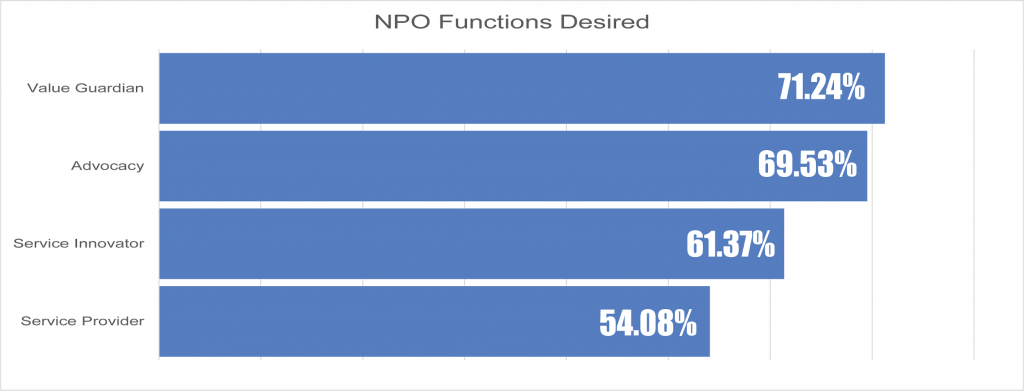
While this report does not take the step of dividing up NPOs into stakeholder subcategories, it is important to differentiate them in terms of how they accomplish their missions to understand the relationship between Comic Artists and their NPOs. The Model of NPO categories discussed in the artist and second party surveys are derived from “Nonprofits: Theory, Management, Policy” by Helmut Anheier with input from “Nonprofit Organizations and Civil Society in the United States” by Kelly LeRoux and Mary K. Feeney
All four varieties of NPOs were desired by a majority of respondents. Respondents had a stronger desire for the two types of NPOs that facilitate longer-term change and social empowerment for artists over the two service types of NPOs. This once again points to a perception of wealth and utility to be had within the comic arts community if not for financial and social barriers.
Value Guardian
Value Guardian: the NPO champions the creation and consumption of the comic arts to the general public to create greater understanding and deeper interest.
The desire for NPOs to act as Value Guardians is consistent between the overall response and all stakeholder subgroups.
A high number (40%) of Second Party Stakeholders see the need with a slightly large number also overestimating (45%)
It is easy to see why artists are attracted to value guardians as they often profess an “all boats will rise with the tide” message for Comic Artists who have a high interest in Community and Empowerment as NPO values. Value Guardian NPOs have some downsides, however. Value Guardians risk overcommitting to the established hierarchies of the comic arts field, benefitting Professional, Comics Insiders, Clear Path, and Enfranchised stakeholder groups over the less engaged stakeholders. Value Guardians risk cynicism on the part of stakeholders who expect effectiveness and efficiency because the outcomes of their work are more difficult to quantify, making it more difficult to prove improvement through evaluation.
Advocacy
Advocacy: the NPO speaks to power on behalf of comic artists, including, but not limited to, the government, courts, comic arts businesses, and other NPOs.
Respondents show a consistent desire for advocacy-based NPOs across all stakeholder subcategories, with the exception of the Professional group. The Professional respondents
show a greater desire for advocacy than the rest of the group (72.09%)
Second Party stakeholders show a bias towards thinking there is a high desire for advocacy (45%).
In an odd reversal, Comic Artists interested in advocacy NPOs need to consider what it will take to empower NPOs advocating on their behalf. NPO Advocates need financial resources likely coming from service fees or dues. More importantly, in some ways, NPO Advocates also need as complete a set of information to work with as possible, meaning that Comic Artists need to share information that may be traditionally taboo to discuss, like sales or page rates.
NPO Advocates should consider what efforts they can take to establish the Comic Artist identity as a distinct entity legally and culturally. Legally, Comic Arts are often not considered separately from illustrators in terms of local grant-making organizations. Similarly, the U.S. Bureau of Labor Services lumps Comic Artists generically under “Craft and Fine Artists” or “Writers.” Advocates seeking to empower Comic Artists should be carving out a distinct cultural and legal identity for Comic Artists to raise the standing of the group.
Service Innovator
Service Innovator: The NPO provides services that are substantively different from similar for-profit services to achieve positive outcomes for artists, such as research into possible alternative market models for the comic arts.
The desire for NPOs to act as Service Innovators is consistent between the overall results and the Clear Path, Unclear Path, Comics Insiders, Comics Outsiders, Enfranchised, and Disenfranchised stakeholder subcategories. Both the Professional and Hobbyist groups show a low desire for innovation: 48.84% and 48.08%. Professionals have the highest stake in the comics industry as it currently works and Hobbyists have the lowest.
A large number (44%) of Second Party Stakeholders correctly assess the desire for innovation.
Innovation is fueled by social capital. This is at the core of the philosophy which states that diversity brings strength. As such, Service Innovators should take note of the high degree of full-time employment among comic artists, as well as examine what stakeholder groups such as Disenfranchised, Comics Outsiders, Unclear Path, and Hobbyists bring to the table. These groups bring different skills and points of view, which, in turn, will drive innovation. Innovators should also take into account some potential pushback from the Enfranchised stakeholder group, the majority of whom (59.56%) who do not see transformation as a desirable value.
Service Provider
Service Provider: The NPO provides services that mirror for-profit services, but use the advantages of nonprofit service to achieve positive outcomes for artists.
The desire for Service Providers is consistent between all stakeholder groups except Comics Insiders and Comics Outsiders. Insiders see a greater need (58.75%) while Outsiders see less of a need (44.55%)
The majority (59%) of Second Party Stakeholders correctly identify Comic Artists’ level of interest in NPO Service Providers.
The means of creating and distributing Comics Art are more accessible than ever thanks to crowdfunding, print-on-demand services, the prevalence of conventions and festivals, and other resources. This likely has the effect of diminishing the need for similar NPO services. In fact, in the case of some services, like conventions and fairs, many Comic Artists may not realize or care which shows are nonprofits and which are not. Service Providing NPOs should embrace the strong desire for community, empowerment, and inclusivity among Comic Artists, putting those elements of their work at the forefront of what they do.
NPO Values desired by Comic Artists:
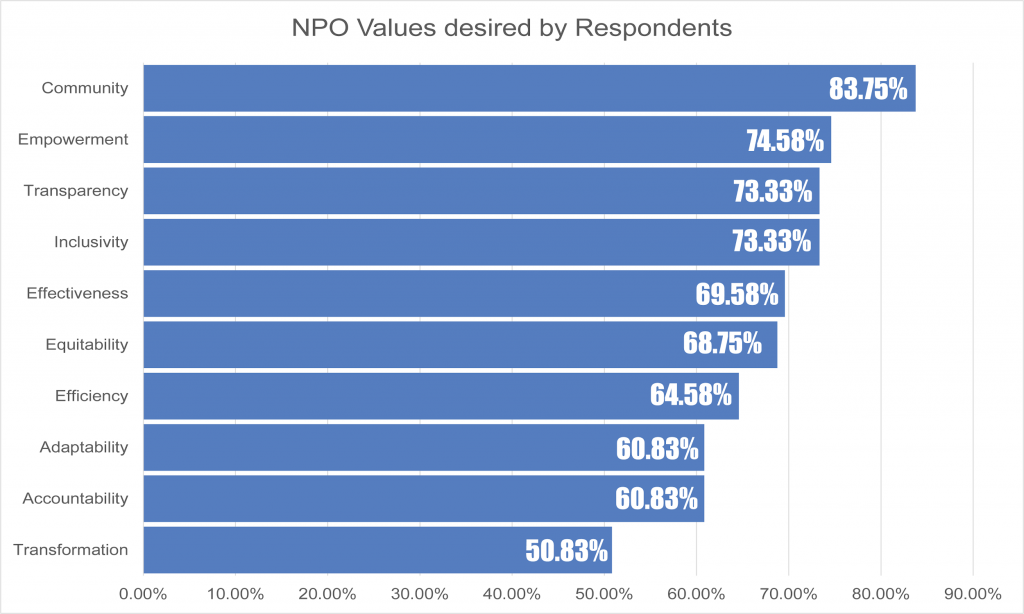
NPOs are often considered part of a “Third Sector”, as they are distinct from the market sector and the public sector (aka government). Actions taken by individuals, movements, and groups within the Third Sector are motivated and governed by their proximity to the community, whereas the market sector is motivated and constrained by financial success and the public sector is bound by the structure of the government.
This gives NPOs a degree of freedom to act independently of powerful stakeholders and institutions, but it does also require that they be in touch with the values of the community that provides governance to them.
In the case of Comic Artists, that becomes a complex thing to navigate. The values presented to survey participants are all derived from the Kirwan Institute’s “Principles for Equity and Inclusive Civic Engagement” by Kip Holley, sections of “Nonprofit Organizations and Civil Society in the United States” by Kelly LeRoux and Mary K. Feeney, and public management resources. All 10 of the values presented were desired by a majority of respondents.
Community
Community: The NPO seeks to build relationships between all members of the comic arts community, creating bridges between its stakeholders such as artists, readers, publishers, retailers, and the NPO’s board itself.
Community is the most widely desired value, desired at a rate consistent among overall respondents and most of the stakeholder subcategories. The Disenfranchised stakeholders have the highest degree of desire for Community at a practically monolithic 89.32%.
The majority (52%) of Second Party stakeholders understand the call for this value.
NPOs should take note of this high desire for bridging gaps within the community regardless of how they function. Comic Artists see an insular tendency in Second Party stakeholders as a source of problems or as barriers to their success. NPOs making the effort to foster communication between Comic Artists and the Second Parties will see an increase in loyalty from the comic artists. Just like charity, communication starts at home… NPOs should begin community building by actively involving Comic Artists in their processes.
Empowerment:
Empowerment: The NPO seeks to make long term improvements in the lives, careers, and social status of comic artists.
The overall desire for Empowerment by respondents is consistent with Clear Path, Unclear Path, Comics Insiders, Comics Outsiders, and Hobbyist Stakeholders. Enfranchised stakeholders have noticeably lower interest (68.38%) in Empowerment. Disenfranchised and Professional stakeholders show notably greater interest (81.55% and 81.40%, respectively)
This value was the most difficult for Second Party Stakeholders to estimate with only 4% correct, 38% underestimating, and 58% overestimating.
That Professional stakeholders are as interested in empowerment as Disenfranchised stakeholders are should be a cause of concern for NPOs, especially Value Guardians and Advocates. Stakeholders at the apex of Comic Arts in terms of professional success are feeling unempowered at the same rate as those who suffer from discrimination and bias, pointing to an industry that is rife with inequities.
Transparency:
Transparency: The NPO performs its duties in a manner that is easily traceable and identifiable to artists and other stakeholders. The NPO is open to further public requests for information.
The desire for Transparency is consistent across all respondents and stakeholder subcategories.
Second Party stakeholders had a bias towards overestimating the rate at which comic artists would desire Transparency (52%).
“Trust but verify” is the name of the game for groups and individuals who value Transparency. This is particularly true of the relationship between Comic Artists and their NPOs as demonstrated by Transparency trumping the desire for Efficiency, Effectiveness, and Accountability. This is not surprising, as Transparency can be viewed as a doorway to Empowerment and Community.
Inclusivity:
Inclusivity: the NPO embraces the gifts of diversity and actively reaches out to and meaningfully engages with artists of socially diverse backgrounds.
The desire for NPOS to value Inclusivity was consistent between the overall respondent groups and across all stakeholder subcategories.
Second Party stakeholders are equally likely to correctly estimate and overestimate the need (44% each)
The key elements of successful inclusivity are outreach and active listening. This makes budgeting time as important as budgeting money in terms of how an NPO allocates its resources. Token efforts will likely have the negative spillover effect of creating cynicism within the communities the NPOs desire to reach.
Effectiveness
Effectiveness: The NPO seeks to create the most or best positive outcomes for artists and guards against negative spillover effects their programs may generate.
The desire for Effectiveness on the part of NPOs is consistent between the overall respondents and all but one of the stakeholder subcategories. Professional stakeholders (62.79%) are less likely to desire Effectiveness from NPOs.
Second Party stakeholders are equally likely to correctly estimate and overestimate the need (42% each).
The strong desire for Effectiveness presents an issue for Value Guardian type NPOs, as their outcomes are often less quantifiable than advocacy and service-oriented NPOs. Value Guardians need to engage in more communication with all stakeholders to gather anecdotal evidence that creates a narrative supporting their effectiveness in lieu of the availability of firm metrics.
Equitability
Equitability: The NPO acknowledges the historical and current roles of wealth, race, and power in the comic arts field. The NPO takes steps to ensure that the needs of artists are not crowded-out by more powerful stakeholders or unfair social norms.
The desire for NPOs to value Equitability is consistent between the overall respondents and the Clear Path, Unclear Path, Comics Insiders, and Comics Outsiders stakeholder groups. The Enfranchised (61.03%), Professional (62.79%), and Hobbyist (59.62%) stakeholders are less interested in Equitability. At 79.61%, Disenfranchised stakeholders are notably and naturally more interested in Equitability.
A large number of Second Party Stakeholders (38%) saw the need for this value with a bias towards overestimating (44%).
The gap between the more empowered stakeholders and the overall response to the desire for Equitability should be a source of concern for Comic Artists and NPOs alike. It is reflective of the insidious nature of institutional racism and cultural bias, where a value can be professed but actual actions reveal a preference for and satisfaction with the status quo.
Efficiency
Efficiency: The NPO seeks to get the most possible out of its available resources (financial and otherwise). The NPO is a good steward of funds: sponsor donations and participating artist service fees alike.
The desire for NPOs to value Efficiency is consistent among all stakeholder subcategories except Hobbyists. Hobbyists show less desire for Efficiency at 53.85%.
Second Party stakeholders show a bias towards overestimation for the desire for this value (46%).
Efficiency is likely more of a value desired by Second Party stakeholders, particularly funders, sponsors, and donors, who want evidence that their contributions are being used to maximum potential. NPOs should consider combining the values of Efficiency and Transparency to increase their status with all stakeholders by doing more reporting on what they actually do with the donations, sponsorships, and grants they receive.
Accountability
Accountability: The NPO is dedicated to self-evaluation and reporting. The NPO is responsive to artist and other stakeholder efforts to engage, including dissent and protest.
The desire for Accountability is consistent between the overall respondents and the Clear Path, Unclear Path, Comics Insiders, and Comic Outsiders. Enfranchised, Professional, and Hobbyist respondents all show a lower need for accountability as a value (52.94%, 55.81%, 51.92%, respectively) Disenfranchised respondents show a notably higher interest in Accountability (71.84%).
Second Party stakeholders generally overestimated the desire for Accountability (48%)
Artists and NPOs both need to see the connection between the more highly and consistently desired value of inclusivity. Failure to wrestle with difficult issues that cause dissent breeds division and cynicism.
Adaptability
Adaptability: The NPO is structured so as to be able to adjust its programs, its initiatives, and even its mission based on input from the community it supports. The NPO is willing to self-correct in the face of its own errors and social change.
The desire for Adaptability on the part of NPOs is consistent between overall respondents and the Enfranchised, Comics Insiders, Comics Outsiders, Professional, and Hobbyist stakeholders. Less need is seen by Clear Path respondents (55.46%) and more need from Disenfranchised (66.99%) and Unclear Path (66.12%) respondents.
The majority (60%) of Second Party stakeholders overestimated the desire for Adaptability on the part of NPOs
Service Innovators and Advocates are most directly affected by this value as agents of change.
The majority of Comic Artists do not see a need for NPOs to be static entities, instead expecting more fluidity in the face of inevitable social change and missteps. This opportunity to acknowledge mistakes and change accordingly should be considered a liberating gift by NPOs.
Transformation
Transformation: The NPO is dedicated to innovation and societal change in support of its constituent artists. The NPO supports and fosters activism.
The desire for Transformation as an NPO value is inconsistent among the stakeholder categories. Enfranchised (40.44%), Clear Path (45.38%), Comics Outsiders (44.55%), and Hobbyists (28.85%) are less likely to desire Transformation. Notably, this is the only value that goes from a majority held position to a minority held position with a group of stakeholder subcategories. Disenfranchised (65.05%), Unclear Path (56.20%), Comics Insiders (56.78%), and Professional (60.47%) respondents all see the need for Transformation.
A large number (44%) of Second Party stakeholders correctly estimated the desire for Transformation. The lower desire for Transformation among more empowered stakeholder groups is reflective of a community where resources are being inefficiently allocated. This presents a barrier for Service Innovators and Advocates to overcome in the recruitment of allies for change. It also presents a challenge for Value Guardians and Service Providers in generating outcomes
Second Party Stakeholder Survey Results
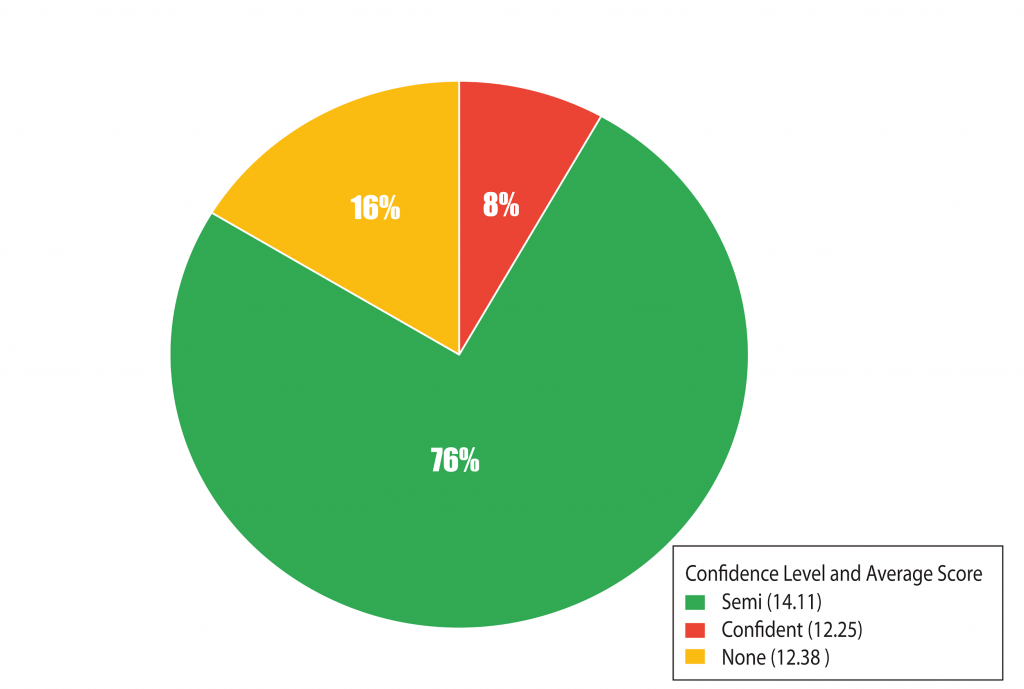
The Second Party Stakeholder survey illustrated how difficult it is to predict the response rates of another group. For a parallel pop culture reference point, consider how hard it is for contestants to consistently succeed on game shows with survey-based questions, such as Family Feud or Card Sharks. Individual biases and cultural stereotypes confound even educated guesses, resulting in both over and under estimation. That’s a drag if you’re going for a brand new car on national television, and, I submit, worse if you are trying to frame real-world problems faced by comic artists. If there is one thing that I would like the entire comic arts community to take away from the Second Party Stakeholder survey results, it is that research (i.e. taking the time to actually ask questions of artists) is a superior starting point for social change for any group of stakeholders.
Graded as a test, the 49 Second Party Stakeholder respondents scores ranged from 2 to 22 out of 37. (5.41% to 59.46% correct) The average score was 13.88 or 37.51%.
In the case of non-multiple choice answers, respondents were given credit for answers that fell within a reasonable proximity. For example, in the questions that asked for a percentage, credit was given for anything within 5% below or above. Unsurprisingly, respondents who are avid fans and/or tied to the Comic Arts professionally scored noticeably above average (14.88 and 14.33 respectively). Both groups likely have a higher likelihood of engaging in a form of political hobbyism specific to the Comic Arts field. To some degree, they already wrestled with and/or done some work related to comic artist identity, giving them a slight advantage in estimation. Simply, avid fans and comic arts professionals can make educated guesses.
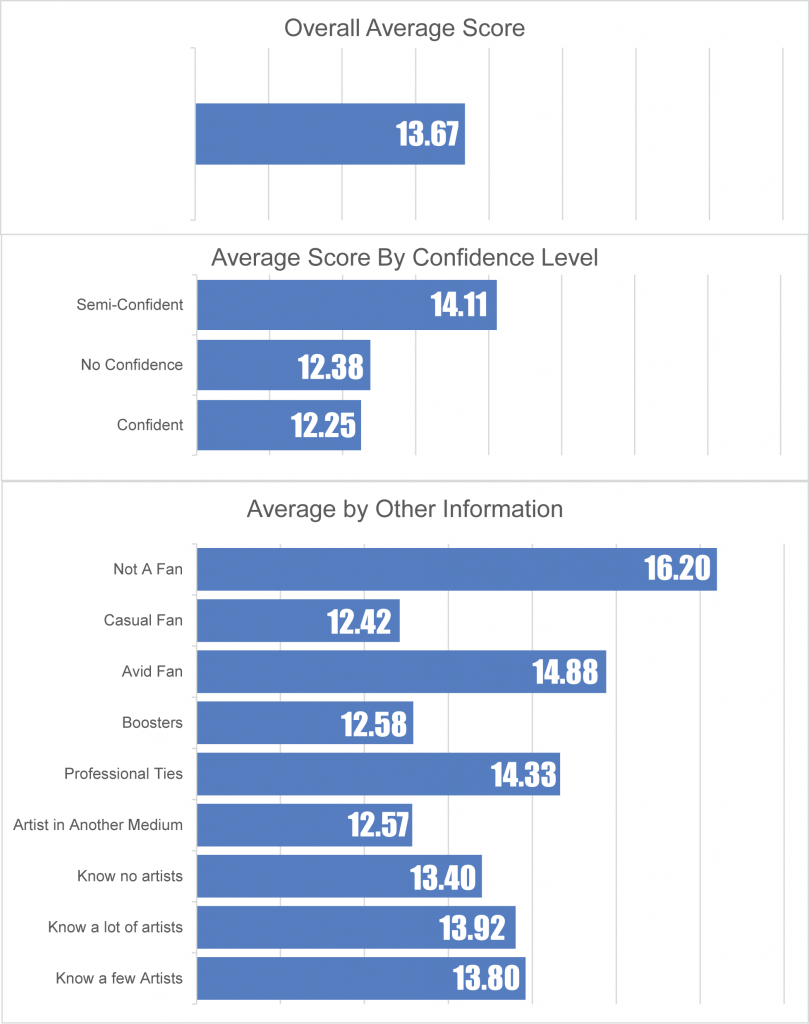
There is very little difference between the respondents who answered the question about knowing artists personally, whether they knew a lot, a few, or no artists. The respondents who did not answer this question at all, however, had considerably below average scores.
The average score of 16.20 for non-fans is surprisingly high. It could be credibly stated that non-fans are not as invested in the cultural stereotypes of comic artists and are therefore less subject to bias. As it is also possible that this was just a good draw of intuitive and sympathetic non-fans, further research would be needed to establish that the high scores are a result of bias.
The relatively low scores of casual fans, boosters, artists in other fields, and those who reported being confident in their answers are likely due to biases based on the cultural stereotype of artists in general and comic artists in specific. Second Party respondents missed the mark when estimating the needs and values of comic artists. The consistent overestimation of needs and underestimation of resources and general satisfaction is reflective of cultural bias towards thinking comic artists are unhappy and underemployed.
The existence of this bias becomes more evident when the accuracy of the respondents is examined on a question by question basis for the entire group. For instance, only 10% of Second Party Stakeholder respondents correctly estimated that only 22% of responding artists held part-time jobs. At the same time, 45% Second Party Stakeholder respondents also dramatically underestimated the number of artists who would have full-time jobs or live off of freelance work. As this was a multiple choice response, truly random guesses would generate a 25% accuracy rate, indicating that there is a cultural stereotype creating a bias in their estimations. This bias can lead to misconceptions in areas important to NPOs. In this case, NPOs making decisions about artist participation based on the stereotype would underestimate the financial resources available to artists as sponsors/donors and overestimate the resource of time available for artists when planning volunteer-based events.
Sources of Income
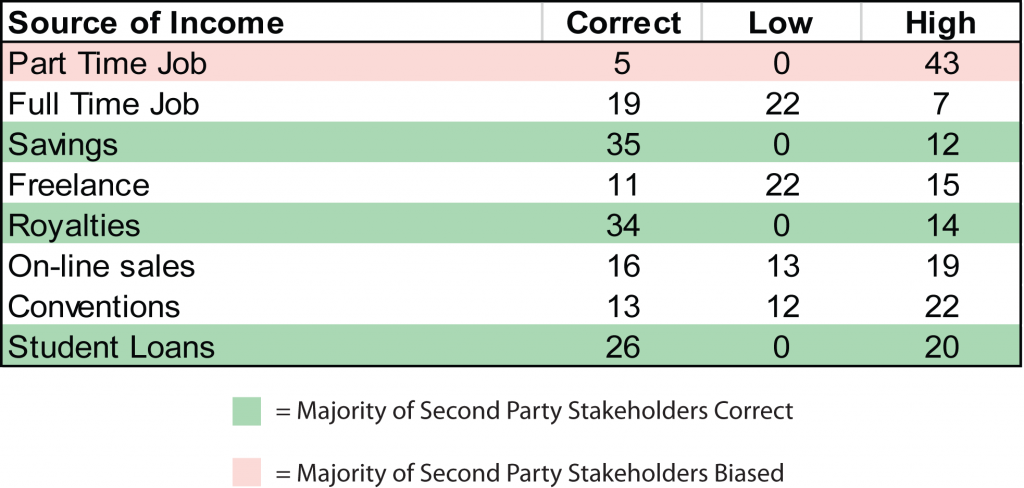
The majority of Second Party Stakeholder respondents understand that less than 25% of artists rely on savings or pensions as a source of income (so much for the myth of the trust fund kid artist!) and a similarly low number of artists receive royalties for their work. The majority of Second Party Stakeholder respondents also recognized that there is a relatively low number of artists who are living off of student loans.
The majority of Second Party Stakeholder respondents showed a bias towards expecting that Comic Artists hold a part-time job. Combined with a tendency to underestimate the number of artists with full-time jobs and overestimating the number of artists who sell online and at conventions or festivals, this points to a cultural stereotype of Comic Artists working part-time jobs to fill in the income gaps left by comics work. The reality is that either by choice or necessity, the majority of Comic Artists hold down a full-time job, which has entirely different implications for problem framing and solving. The financial resources of comic artists may be greater than anticipated, while available time is less.
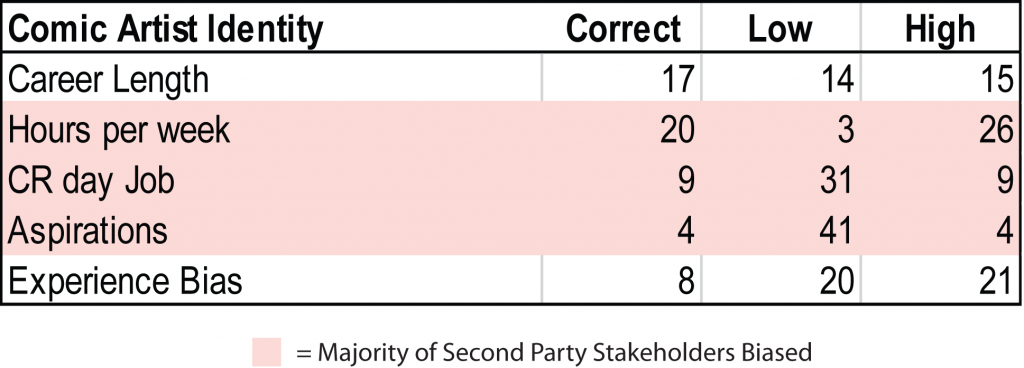
Other Comic Artist Identity Questions:
This set of questions was posed to Second Party Stakeholder respondents as open answer, as opposed to multiple choice, and so were considerably harder to get correct. Credit was given for correct answers if the respondents guessed between 10 and 15 years on career length if any part of their answer touched the 14 to 21 hour range of respondents to the first survey, and credit as correct was given for any estimation within 5% above or below the actual percentage on the final three questions.
The majority of Second Party Stakeholder respondents showed bias in overestimating the number of hours per week Comic Artists work. This is likely tied in with the cultural stereotype mentioned above, with Second Parties believing that Comic Artists essentially work on comics in a full-time capacity and supplement their income with part-time work.
The majority of Second Party Stakeholders also showed bias in significantly underestimating the number of artists who saw a clear path to their artistic aspirations and the number of artists who work in a comics-related day job. The former is likely due to a cultural stereotype of the arts in general, and comic arts in particular, being a notoriously difficult vocation. The “comics will break your heart, kid” type memes and anecdotes carry more weight culturally than positive comments by comic artists who enjoy their work. It is more difficult to establish why Second Parties consistently underestimate the number of artists who report having comics-related day jobs, although the fact that Second Parties also consistently underestimated the importance of “community” as a value in the final section may point to the insular nature of the comics industry creating a perception that it is smaller or more exclusive than it in reality is.
Second Party Stakeholder respondents were split almost equally high and low in terms of their estimate of how many artists belong to a group that experiences bias. It was perhaps the most difficult question to interpret, as the respondents needed to not only estimate the relative size of different identities but also estimate my ability to reach disenfranchised groups.
Desired NPO Activities
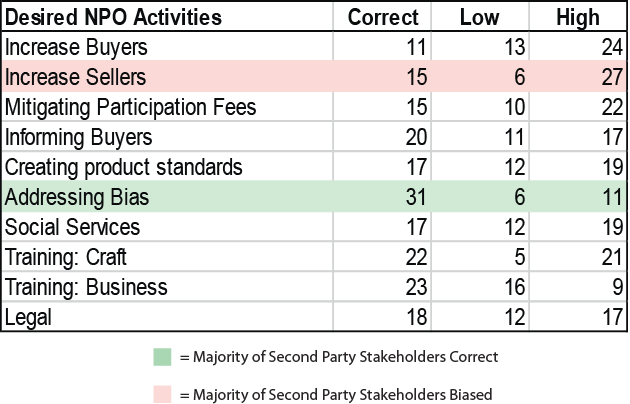
The majority of Second Party Stakeholder respondents correctly estimated the number of artists who wanted NPOs to address discrimination. This is likely reflective of current events in the comic arts community, such as the ongoing provocation of the ComicsGate movement on matters of race and gender, as well as the large number of sexual predators exposed in recent months.
The majority of Second Party Stakeholders also show a bias towards overestimating the number of Comic Artists who would desire an NPO that increases the number of sellers in the market place. Sellers were defined in both surveys as publishers, retailers, and distributors. This points to the Second Party Stakeholders perceiving a gap in opportunities that comic artists don’t. This is likely related to the general perception that the comics industry is a tough place with limited opportunities, which is evident in Second Parties underestimating the number of artists who see a clear path to their aspirations.
Second Party Stakeholder respondents tended towards the overestimation of desired activities in general. This tendency also correlates with the perceived lack of resources and satisfaction that the Second Party Stakeholder respondents indicated in the first part of their survey. The only activity that showed a bias towards underestimation was the desire for training in the business of making comics. This somewhat monolithic vision of artist needs is indicative of a cultural stereotype of artists being financially and professionally beleaguered.
Desired NPO Functions

The majority of Second Party Stakeholder respondents understood that there is a strong desire among comic artists for NPOs that provide services. A noticeable number of Second Party Stakeholder respondents, though not a majority, underestimated the desire for NPOs that provide innovative services and overestimated the desire for Value Guardians and Advocacy.
Desired NPO Values
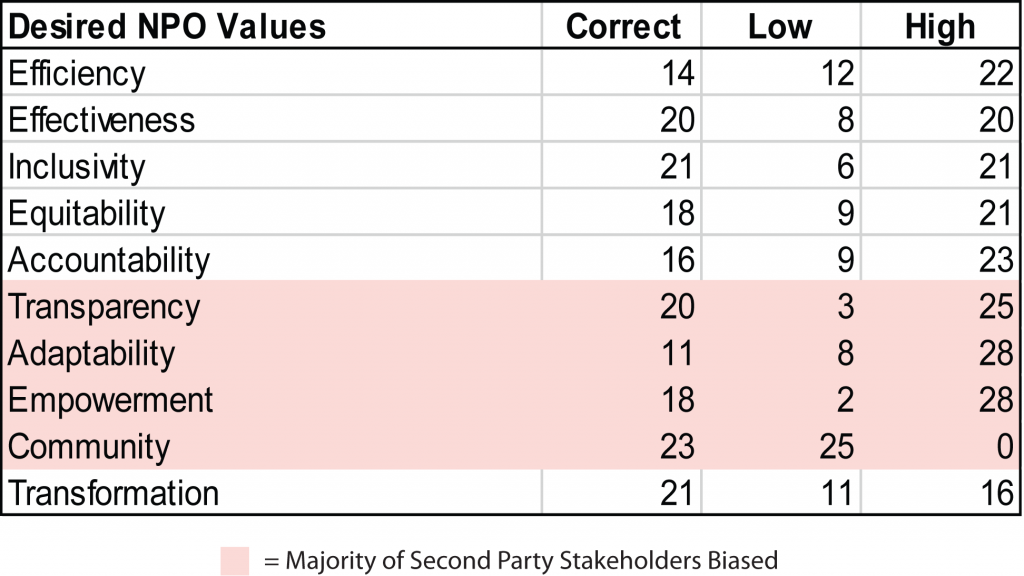
The majority of Second Party Stakeholder respondents showed a bias towards overestimating the desire for Transparency, Adaptability, and Empowerment and a bias towards underestimating the desire for Community. The values of Transparency and Empowerment were both very highly desired by the comic artist respondents, so the overestimation may in fact be prevalent but slight. It is also important to note that both Transparency and Empowerment are common buzzwords used both by NPOs stating their mission and against NPOs when they face criticism, possibly leading to the overestimation on the part of Second Parties. The slightly low estimation of the desire for Community as a value may stem the perception that the existing comic arts community is a fairly tight, if insular, group. Adaptability is the value most overestimated by Second Party Stakeholders.
Examining the Cultural Stereotype of Comic Artist Identity
The graphic below represents a visual map of the Second Party Stakeholder respondents’ vision of the comic artist identity and its needs. The green area shows the aspects of the comic artist identity that the respondents correctly assessed, yellow underestimated and red overestimated.
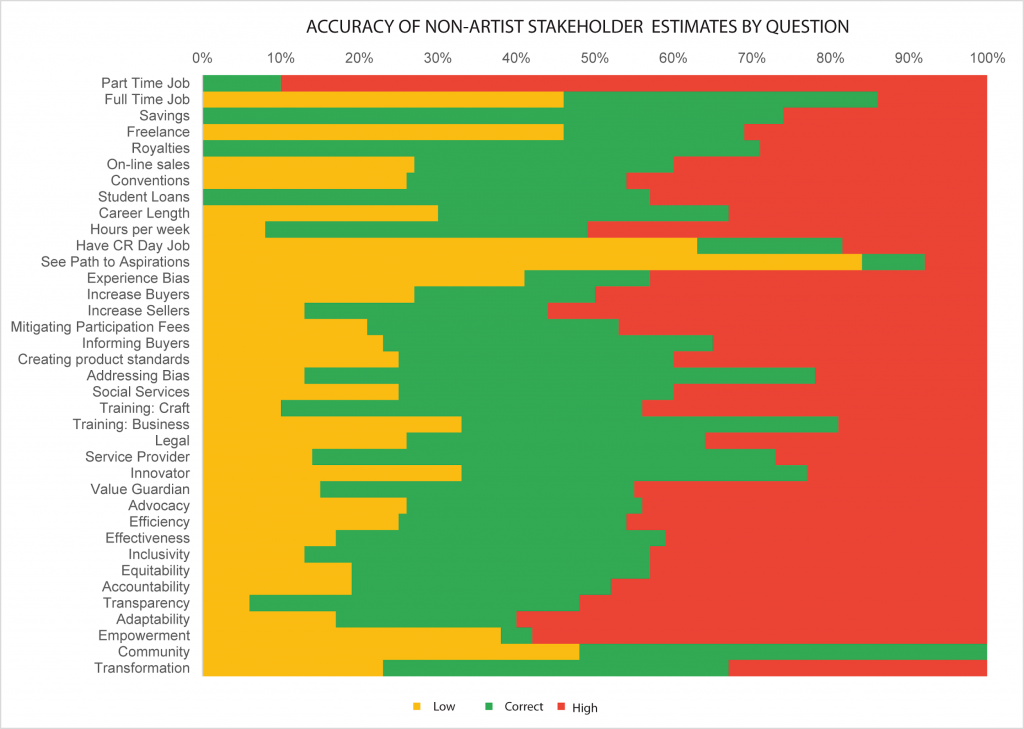
The tendency for overestimation may be due to the positive nature of the service, function, and value definitions. It is too easy to flip the question mentally and ask oneself “why WOULDN’T someone want a NPO to be efficient or adaptable?” There are, of course, reasons, not the least of which is that values can conflict with one another (for instance, innovative NPOs that value Transformation may not always be able to guarantee efficient or effective programs. The experimental nature of their work prohibits consistent program outputs and outcomes). The artists would be taking those potential conflicts into account and weighing them to their specific needs. This creates a nuanced point of view that Second Party individuals may not share.
This lack of nuance amplifies the issues of cultural stereotypes. It creates a perception that all activities and services are equally welcome and desired by Comic Artists. That perception can create issues with how NPOs with broader mission statements allocate their limited resources.
The Undeniable Impact of Discrimination and Bias (Continued)
The difference between Enfranchised and Disenfranchised stakeholders does not end with professional metrics. Disenfranchised stakeholders expect different things from the Enfranchised group in terms of services and values from NPOs. As noted in Part One of this essay, this difference is crucial in that Disenfranchised voices are likely underrepresented in these survey results. A more representative sample of the Comic Artist population would likely cause a shift towards the opinions of the Disenfranchised stakeholders.
Desired NPO Activities:
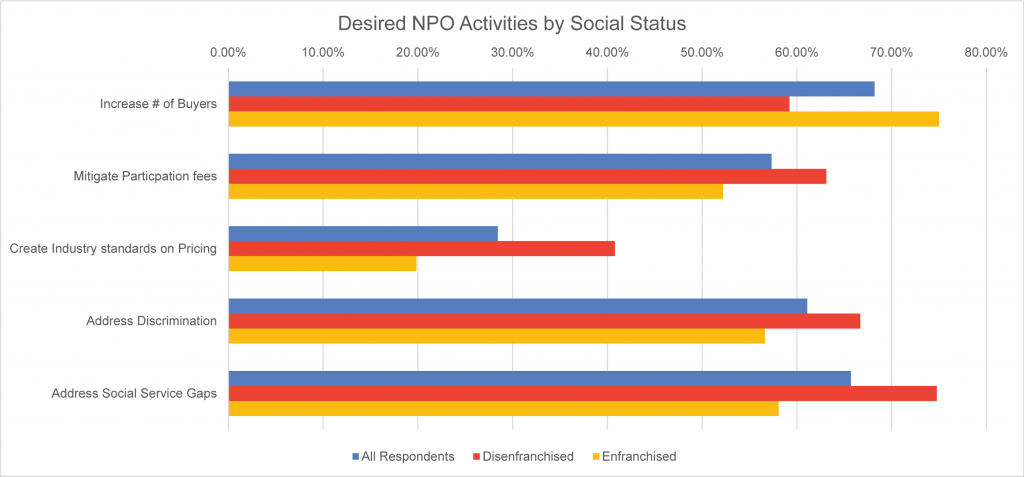
Disenfranchised respondents show considerably less interest in NPO services aimed at increasing the number of buyers in the field. (59.22% compared to 75% for Enfranchised). It is notable that the majority of Disenfranchised respondents still would like to see such services, but they show a greater desire to addressing barriers to entry to the marketplace and the well being of the artists in the marketplace as a greater need than growing the marketplace. Based on responses in the values sections of Part 2 of the Artist Survey, it is likely that Disenfranchised respondents have a belief that adding more buyers only helps the Enfranchised parties in the market. With differences ranging from 10.90% to 20.93%, Disenfranchised respondents support NPO activities that mitigate participation fees, create industry standards in format and pricing, address discrimination, and address social service needs at greater rates than Enfranchised respondents.
Disenfranchised and Enfranchised respondents had very similar desire rates for increasing the number of sellers, informing buyers about their products, training in both the craft and business of making comics, and legal support in matters of copyright and censorship.
Functions
The greatest area of concurrence in the survey between Disenfranchised and Enfranchised respondents comes in the matter of how they would like NPOs to function in their community. All options, Service Provider, Service Innovator, Value Guardian, and Advocacy were desired by the majority of both groups. The Disenfranchised respondents (65.05%) were less likely than Enfranchised respondents (72.79%) to be interested in NPOs acting as Value Guardians, which is likely reflective of an element in the community that feels such organizations support existing hierarchies.
Values
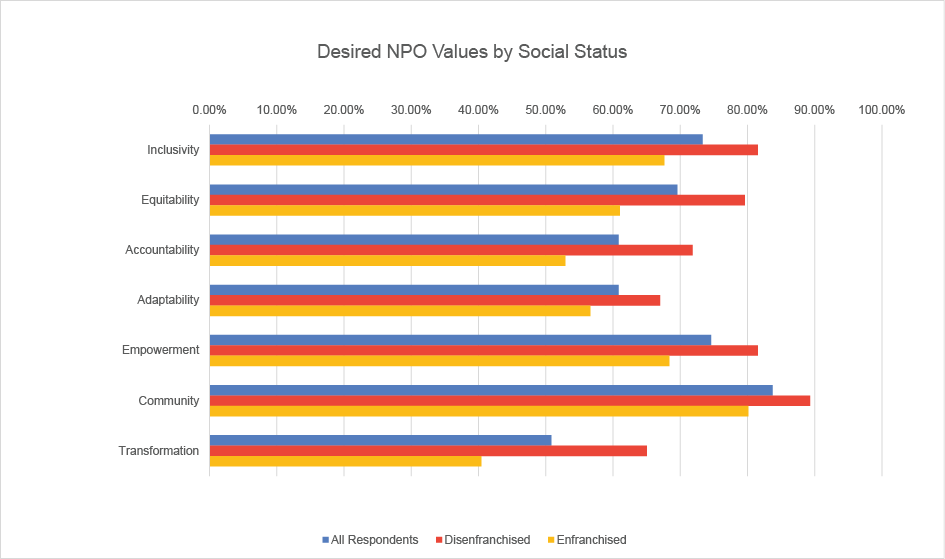
As might be expected, the area in which Disenfranchised and Enfranchised respondents show the greatest dissonance is in the values that they expect from NPOs in the comic arts community. Overall, the majority of respondents wanted each value to be maintained by NPOs, with no response rate being less than 50%. This is mostly still true when responses are split between the Disenfranchised and Enfranchised groups, but with some striking differences. The Disenfranchised group in general expects more values to be maintained by NPOs and at higher rates. In particular, Disenfranchised respondents professed a greater desire for values that involve access issues and change. The most striking difference is in the value of Transformation, where there is nearly a 25% gap between the two groups. At 40.44% of respondents, Transformation is the only value not desired by a majority of Enfranchised respondents.
The only two values that Disenfranchised and Enfranchised respondents have a general concordance on are Efficiency (64.08% to 64.71%) and Transparency (72.82% to 74.26%).
Conclusions
- Comic Artists see a high degree of interest in activities and services from NPOs. The majority of Comic Artist respondents saw a need for 7 of the 10 listed NPO activities.
- The highest overall interest among respondents in NPO services is providing legal services.
- A minority of artists saw a need for NPOs to aid in increasing the number of sellers, training in the craft of making comics, and/or creating industry standards in format and pricing.
- Disenfranchised respondents are more interested in activities geared towards eliminating barriers than those that simply grow the field.
- There is a majority interest among Comic Artist respondents in seeing NPOs function as all four functions: Service Providers, Service Innovators, Advocates, and Value Guardians.
- Value Guardianship is the most desired of all four functions, although, notably, Disenfranchised respondents were less likely to desire a Value Guardian.
- There is a majority interest from the Comic Artist respondent group in NPOs acting on all listed values.
- Community is the most desired value by a considerable margin.
- The majority of Establishment respondents (59.56%) do not value Transformation.
- Disenfranchised respondents have a higher degree of interest in activities that lower barriers to entry into the field and generally have a higher expectation of ethics from NPOs especially in values that promote change.
- Enfranchised respondents are more resistant to change and generally support activities that increase the size of the existing comic arts market.
- Second Party stakeholders generally had a hard time estimating the Comic Artist respondents overall response rates, pointing to the need for communication in any group or individual doing a stakeholder analysis in the field.
SOLRAD is made possible by the generous donations of readers like you. Support our Patreon campaign, or make a tax-deductible donation to our publisher, Fieldmouse Press, today.

Leave a Reply